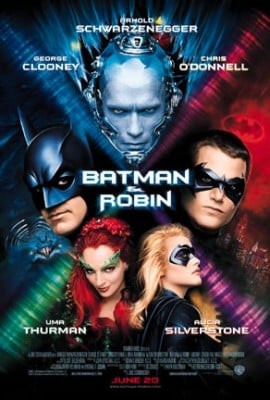Latest Gear Live Videos
Monday December 1, 2008 8:52 pm
Batman and Robin: Opposing Viewpoints (Part One)

My co-worker told me once that his brother liked “Batman and Robin”. I said to myself that in no way was that even possible. Well, he doesn’t like “Batman and Robin,” but he does like it a bit and feels some of the criticism about the film is too harsh. I decided that this would make for a good blog and I asked him to write a review of the film while I would write my own. Here is his review:
YES, THAT’S RIGHT, A DEFENSE OF BATMAN AND ROBIN…
by Evan C. Price
Viewing Joel Schumacher’s Batman and Robin for the first time since its release in 1997, I am surprised at the contempt for this sequel among comic book fans, IMDB and Ain’t-It-Cool regulars, and the usual assortment of internet grumps and trolls.
“Bane was a complex villain and they ruined him.”
“The worst comic book film ever made.”
“It raped my childhood.”
And so on.
Read More  | Wikipedia
| Wikipedia
For one thing, I would wager that if you asked a good many of the people who have seen the film, but are not comic book fans and do not have any strong opinions of what the character should be beyond what he is - a superhero in a bat costume - they would get it confused with other Batman installments. Ask a family member or co-worker. Even my father, a movie buff for most of his life, recently inquired about the title of “the Batman with Danny DeVito,” mixing it up with the “Jim Carrey one” while glancing at an ad for The Dark Knight. Many people outside of the comic book world are simply looking for an adventure that will pass the evening; one Batman is as good as another. Roger Ebert - who gave Batman and Robin two stars, the same rating he affixed to Batman and Batman Returns - wrote that the film is not much different from Tim Burton’s (failed) attempts, that it also has “nothing authentic at its core.”
Prior to Christopher Nolan’s ponderous “Batman Begins,” little in the series had really been about Batman anyway. Burton was more interested in freak shows and set a pattern of needlessly villain-stuffing the frame. It was Schumacher who directed his leading man (Val Kilmer) to define the duality of Bruce Wayne, giving the character some much-needed warmth (as opposed to Burton with Michael Keaton, whose interpretation of Wayne was distant and confused).
For another thing, “Batman and Robin” isn’t that bad. An expensive production estimated at $125 million, the film was overwhelmed by its set design and became an audio assault in multiplexes. But in the decade that followed we’ve had an ever-present ADD editing style and incomprehensible “shaky-cam” to go with all that noise, so Batman and Robin seems almost quaint. The opening fight scene - an exciting brawl pitting Batman and Robin against Mister Freeze’s henchmen in a frozen Gotham City Museum of Natural History - is shot and edited in such a way that we are allowed to see the choreography, allowed to see punches and kicks, allowed to see someone going butt-over-teakettle, without a lot of this nonsense so typical of Paul Greengrass’ Bourne films (and Batman Begins), as if the filmmakers sought to elicit excitement through total disorientation.
I’m not running through the usual checklist of flaws and embarrassments in “Batman and Robin,” rather, I’ll start by agreeing with most of the criticism so often hurled in the direction of an admittedly sub-par film: that (in general) it’s shoddily written, poorly acted, and campy to the point of being smug and obnoxious.
However:
RE: PERFORMANCES - Oscar-winning screenwriter Akiva Goldsman’s dialogue - alternately bland and unfunny - is next to impossible for speaking purposes. The overpaid actors try hard, though, by pushing camp as far as it goes. Some are more successful than others. Governor Arnold Schwarzenegger probably modeled his performance on fellow Austrian Otto Preminger’s from the 1966-68 television series: it has a similar - and similarly amusing - charm. In ‘97 George Clooney was still bobbing and rolling his head, refusing to discipline himself as a leading man, but he’s hilarious when Wayne tries to explain himself (“We cut our funding. It was a conflict of ideologies. Doctor Woodrue was a lunatic”) or when Batman informs a bumbling Jim Gordon (Pat Hingle) that the commissioner has “eleven minutes to thaw these people!” It’s too bad Clooney didn’t land the role with a better script, because he does make a decent Batman.
RE: ACTION BEATS - I’ve already addressed the strength of the fight scenes, but would also add that Schumacher had a better handle on them than either Burton or Nolan. He can stage massive, spectacular set-pieces clearly defining where people are and what they’re trying to do. During the museum scene there is one swooping, overhead tracking shot as Batman and Robin are surrounded by Mister Freeze’s thugs. It’s held long enough to establish setting and placement of characters. The sequence does not resort to meaningless close-ups as random hoods get punched in the face minus any spatial context.
Its action recalls the opening of “Indiana Jones and the Temple of Doom,” as various people are trying to grab an object - a diamond - that is continually kicked or batted out of someone’s reach to humorous effect. This is all very silly, like an Ice Capades show run amok. It is also visually imaginative and fun to watch. Like Spielberg, Schumacher understands that the scene works best if constructed like a dance, a kind of Hollywood musical number, and not just a monotonous staging of blows and kicks.
Sometimes - rarely, but sometimes - Schumacher even understands when less is more. Near the close of an exhausting car chase, Batman smashes through a truck windshield and barrels into his opponent, fists flying. Rather than throwing another fight scene at us, Schumacher transitions gracefully to a shot of Batman pulling his cape away to reveal an unconscious Freeze at his feet. It is a surprisingly artful tableau.
RE: ENVIRONMENT - Of the three Batman directors, Schumacher is the only one who has been consistent with his “world,” that of a colorful fantasyland aimed at children. He never strays from that vision. The sets are impossible, props comically generic (“POISON”). There are sound effects stolen from Tex Avery cartoons. Poison Ivy (Uma Thurman) crashes a party at the Gotham Observatory, stripping out of a gorilla suit and spraying her opponents with a bright green perfume that floats menacingly in the air. There is never any doubt that we have journeyed to a comic book setting in which unbelievable personalities do unbelievable things.
Now compare that vision to Christopher Nolan’s for “Batman Begins”. Is it natural or fanciful? Are we looking at Gotham City or Chicago? If the Tumbler is meant to be a realistic alternative to the Batmobile, then why is the guy driving it still in a 90-pound rubber costume? Why does the Scarecrow wear a business suit with a burlap sack over his head? (Doesn’t that make him seem ridiculous?) How can anybody in a story so fundamentally silly look somber all of the time?
RE: RANKIN/BASS (IN CONCLUSION) - Any adventure movie where the villain leads his henchmen in a sing-along to “Snow Miser” is deserving of a little praise. So go easy, guys.
Read Part Two of the argument written by David Torres.
Advertisement
Advertisement
Advertisement
© Gear Live Media, LLC. 2007 – User-posted content, unless source is quoted, is licensed under a Creative Commons Public Domain License. Gear Live graphics, logos, designs, page headers, button icons, videos, articles, blogs, forums, scripts and other service names are the trademarks of Gear Live Inc.












Comments: